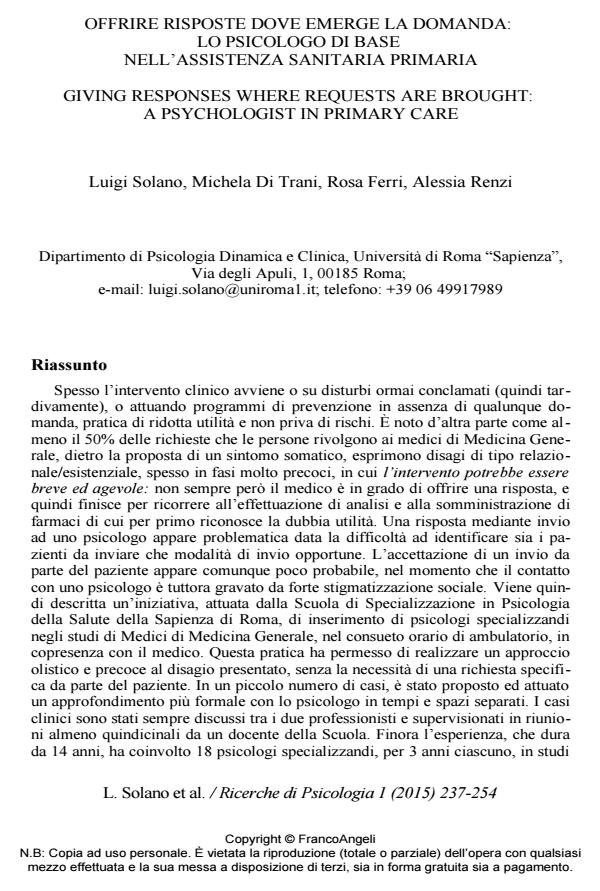Giving responses where requests are brought: a psychologist in primary care
Journal title RICERCHE DI PSICOLOGIA
Author/s Luigi Solano, Michela Di Trani, Rosa Ferri, Alessia Renzi
Publishing Year 2015 Issue 2015/1
Language Italian Pages 18 P. 237-254 File size 239 KB
DOI 10.3280/RIP2015-001015
DOI is like a bar code for intellectual property: to have more infomation
click here
Below, you can see the article first page
If you want to buy this article in PDF format, you can do it, following the instructions to buy download credits

FrancoAngeli is member of Publishers International Linking Association, Inc (PILA), a not-for-profit association which run the CrossRef service enabling links to and from online scholarly content.
Clinical intervention often takes place either on patent disorders - that is, very late - or by implementing prevention programmes in the absence of any request, this practice being of reduced usefulness and not devoid of risks. It is well known, on the other hand, that 50% of requests brought to family physicians, though expressed as physical symptoms, often derive from relational/existential problems, often at a very early stage, when intervention would be short and easily feasable: quite seldom, however, is the physician in a condition to meet this demand adequately, and so ends up prescribing clinical investigations and drug treatments the usefulness of which the physician herself finds strongly doubious. Progressive differentiation between medicine and psychology makes co-operation through referral to a psychologist quite problematic, in terms of both which patients are referred and the modalities of referral. Acceptance of psychological referral is in any case difficult, due to the social stigma that still surrounds contact with mental health operators. The paper reports an experience implemented by the postgraduate Health Psychology School of the Rome University ‘Sapienza’, entailing joint, direct co-operation between primary care physicians and psychologists through the psychologist’s presence in the doctor’s office during consultations. Such an arrangement allows direct access to a psychologist’s listening and intervention in the absence of any filter and without the need for a formal request on the patient’s part, so overcoming the fear of social stigma. In a small number of cases, more formal consultation with the psychologist was proposed. This setting allowed an exploration of the meaning of any complaint brought by patients (physical or mental) in the context of the individual’s past and/or present relational situation, in a very early phase. The experience, beginning in 2000, has until now involved 18 psychologists for a period of 3 years each: it appeared as entirely feasible, though requiring several months for adaptation; patients have welcomed the presence of the psychologist and, as expected, took a broader approach in reporting their distress. In two cases where data were available, a substantial (17% and 14%) reduction of drug prescription on part of the physician was recorded. A clinical vignette shows how disclosure of a difficult life situation, initially expressed as a physical symptom, not only brought to resolution of the symptom itself, but also facilitated crossing an important stage of the life cycle in an adolescent.
Keywords: Primary Care Psychologist, family physician, somatic symptoms, psychological needs
- Primary care psychologists working with general practitioners in an Italian area affected by earthquake and during Covid-19 pandemic: results from 10 years-long experimentation Enrico Perilli, Angela Paris, Matteo Perazzini, Danilo Bontempo, Simona Marcotullio, Federica Carubbi, Barbara Catania, Marialuisa D’Agostino, Sara Citerei, Cecilia Cappuccini, Olimpia Paris, Laura Paolucci, Martina Bucci, Stefano Cobianchi, in PSICOLOGIA DELLA SALUTE 2/2025 pp.128
DOI: 10.3280/PDS2025-002008
Luigi Solano, Michela Di Trani, Rosa Ferri, Alessia Renzi, Offrire risposte dove emerge la domanda: lo psicologo di base nell’assistenza sanitaria primaria in "RICERCHE DI PSICOLOGIA " 1/2015, pp 237-254, DOI: 10.3280/RIP2015-001015